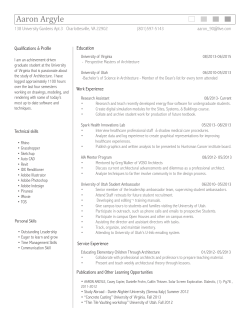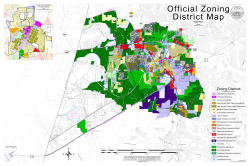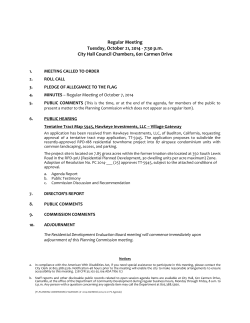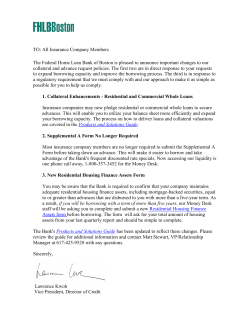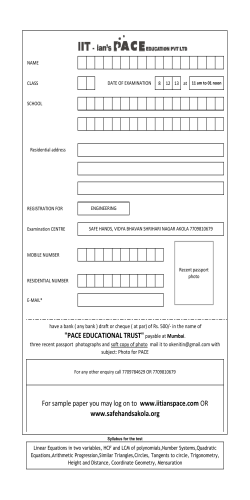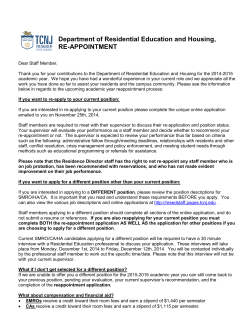
Draft Comprehensive Plan Update
Executive Summary Proposed Amendments to the Argyle Comprehensive Plan January 21, 2015 The Argyle Comprehensive Plan was adopted in March 2009 and serves as a guide for future development and represents policy and generalized land uses proposed for the Town of Argyle. The items below briefly summarize the primary components of the Comprehensive Plan that are being considered as part of these proposed amendments. 1. Future Land Use Plan Map Amendments – The boundaries between the various transects have been revised to follow existing property lines. The current map exhibits an “organic” style of transect boundary lines which has led to interpretation challenges on those properties that contain multiple transect designations. 2. Removal of the “Discouraged” Land Use Category – The “Discouraged” category illustrated in the Land Use Breakdown charts in all transects have been removed, which leaves the remaining “Recommended” and “Suitable” categories available as guidelines for all future zoning/land use decisions. 3. Introduction of the T3-A Transect – The unique challenges and impacts of the Union Pacific Railroad on properties immediately to the west offers opportunities for new high-quality singlefamily neighborhoods buffered with large-scale open spaces that would accommodate a public trail system stretching southward from Crawford Road to the southern ETJ line and connecting to trails within Canyon Falls and to future AISD school campuses to the south. The proposed T3-A (Low Density Railroad Transition) Transect, which requires exclusively single family residential uses, illustrates a “Recommended” density of 1 unit per acre and a “Suitable” density of 1.25 units per acre with a minimum of 30% open space in order to facilitate the required public trails, landscaping and buffer areas. In contrast, the existing T3 (Low Density Transition) Transect suggests that neighborhood commercial uses occupy approximately 10% of the transect area and public facilities occupy approximately 15% of the transect area. The T3 Transect also does not promote the large scale open space and trail system that embodies the T3-A Transect. 4. Conservation Option Added to T2 – Conservation developments are currently listed as a land use option in the T1 (Rural Conservation) Transect and can be used as a tool to preserve and protect Argyle’s most treasured natural resources. The T1 Transect currently lists 10 acres per dwelling unit as “Recommended” and 5 acres per dwelling unit as “Suitable” with variances for conservation development at one dwelling unit per acre as an alternative option. The T2 Transect currently lists 2.5 acres per dwelling unit as “Recommended” with no other options. The Conservation development option has been included in the T2 (Rural Residential) Transect to further promote and protect the natural environment in the T2 areas as is suggested in the T1 areas. 5. Recognition of Existing Development in the Future Land Use Plan – Several existing neighborhoods previously developed are depicted on the current Future Land Use Plan with transects that do not align with the existing development patterns on the ground. In the amended Future Land Use Plan, these neighborhoods are included in transects that more closely reflect the characteristics exhibited by these neighborhoods today. Comprehensive Plan Update Mesa Design Adopted March 2009 Petty & Associates, Inc. Updated Spring 2015 Argyle, Texas Note: All Amendments are highlighted in yellow. ADDENDUM SPRING 2015 Table of Contents..................................................................................................................................,,.......... vii(a) Land Use Plan and Thoroughfare Framework............................................................,,,,,,,,,,,,,,,,,,,,,,,,,,,,,,.......... 39 Figure 5. The Land Use Plan for Argyle................................................................................................................ 43 Figure 6. Transect of Land Use Centers............................................................................................................... 44 T2 Rural Residential with Conservation Option T3A Railroad Transition Residential Building Function Matrix ....................................................................................................................................... 53 Transect Districts/Building Function ..................................................................................................................... 57 Transect Detail...................................................................................................................................................... 60 Form Based Standards T3 and TA........................................................................................................................ 73 T2 District Standards with Conservation Allowance added.............................................................................. 77,78 Future Land Use Plan ........................................................................................................................................ 135 vii(a) Comprehensive Plan Update LAND USE PLAN AND THOROUGHFARE FRAMEWORK Future Land Use Plan: Fulfilling Public Goals MESA was hired by the Town of Argyle in the late spring of 2007 to update the Town’s existing Comprehensive Plan. Most important among those portions of the Comprehensive Plan document needing update was the land use component. The Town also wanted to create corridor overlays for the main roadways, and since land use and corridors are closely related, the two goals were combined in this Land Use Plan. The rigid descriptive nature of Argyle’s existing Land Use Plan did not give the Town Council true guidance when it came to administering the growth management objectives of Argyle’s population. Achievement of this goal requires a new and different approach to land use, based more in the regulation of outcomes than the regulation of entitlement. To embark upon such an innovative plan approach, it was necessary to bring participants in various public workshops through a process of affirming the intents of the existing Land Use Plan without getting bogged down in the allocation of entitlements associated with its rigid format. This meant consideration of changes to the Plan itself as a way of externalizing its purpose/ intent and deliberation of the growth potential of Argyle (and the Argyle vicinity) in light of Argyle’s desire to maintain a certain population and quality of life. The maintenance of a small population places greater burdens upon the intensity and value of non-residential development. When small populations are unable to fund the cost of services, they become dependent on non-residential development to close the “tax gap”. The Tax Gap analysis discussed earlier in this report demonstrates that achieving a population cap at 13,000 people would require intense non-residential development along I-35W and within the Argyle’s commercial core. Through this process it was clear that the Citizens of Argyle desired to: • Balance economic development with population targets of Argyle. • Maintain a population cap at 13,000 people. • Encourage nodes of development to preserve the open landscape. • Preserve the natural assets and natural corridors of Argyle by using them to influence and shape patterns of physical development. • Create villages and nodes of commercial aggregation. • Establish a recognizable system of regional and local thoroughfares. • Provide flexibility to respond to future market conditions and population trends. Guided by these statements of intent, MESA investigated approaches to land use that would fulfill Argyle’s goals and vision. Argyle can be considered as one Town with separate zones, with the boundary of these zones as the ridgeline that defines the edge of the Cross Timbers. This ridgeline and major transportation corridors run from north to south, and organize much of the built form of the Town. These major north-south transportation corridors are met by east-west roads at intersections, where concentrated development would benefit from high traffic volumes. For example, Crawford Road runs east-west in the northern half of town, and FM 407 runs east-west in the southern half of town. I-35W’s influence and regional connectivity in the west, as well as the road’s separation from other portions of Argyle by the ridgeline, create suitable areas for regional commercial development and higher density districts. For the Argyle Comprehensive Plan Update, MESA designed a transect to illustrate the ten land use districts and their relationship to each other (Figure 1). The transect approach to land use planning can be thought of as a spectrum of density, ranging from highest density around commercial nodes to lowest density in the more rural zones of town. Beginning with the more dense commercial development in the west, each sequential district in the transect steps down in density and intensity of development recommended. This transition continues within each district and from district to district, changing the character of development possible in a consistent manner that concludes with the protection of the rural environment so prized by Argyle’s residents. Figure 1. Transect of Districts in Argyle. Land Use Plan and Thoroughfare Framework 39 The Land Use Districts Within the Land Use Plan for Argyle, a constellation of Land Use Districts is arrayed. Because of existing entitlements (associated with current zoning), each of the Land Use Districts is basically a “mixed use district”. However, the range of permitted uses is consistent with (and reinforces) each district’s visual character and desired development image. Therefore, commercially dominant districts along I-35W permit a broader range of appropriate uses at greater densities, controlled through the Form Based Standards described in the following section, while the residentially dominant districts seek to preserve rural character and views. The Argyle Land Use Plan (Figure 5, refer to Appendix for color version) is a design based allocation of potential entitlements to be negotiated to achieve the greatest design benefits for the community. Figure 5. The Land Use Plan for Argyle. Land Use Plan and Thoroughfare Framework 43 Figure 6. Transect of Land Use Centers. The Land Use Districts are comprised of both centers and corridors. The centers (Districts T-1: Rural Conservation to T-6: Regional Center) are sequential and (starting with most rural and lowest density) reflect increasing levels of density, urban-ness, commercial dominance, and regional significance. Each of the centers permits a cluster of specific land use types (e.g. Single Family Residential) that are either recommended at certain densities, suitable at certain densities, or discouraged. The centers of Argyle (Figure 6) are: T-1: Rural Conservation District The Rural or Conservation Residential districts have very low density single family houses, with some public facilities. Conservation development, if used, cannot exceed existing density requirements and is subject to Town development review process. The projected target population is 415 to 515 residents. T-2: Rural Residential District with Conservation Option Rural Residential district land uses with Conservation option are single family houses located on large lots. Some public facilities may be present in this district, which has a projected targetpopulationof1,130to1,230residents. This district is a transition zone from commercial to rural residential uses and has a projected target population of 1,400 to 1,800 residents. Density is recommended to be 1.0 units per acre with 1.25 considered suitable based on the discretion of the Council. Open Space and trails are crucial design features within this District which requires 30% open space and connecting trails along the railroad ROW. T-4: The Village Center District Village Center land uses are a mix of residential and commercial, with some public facilities. This medium density, pedestrian oriented district will capture value from the intersection of FM 407 and US 377, and has a projected target population of 1,145 to 1,245 residents. T-5: The Town Center District The Town Center is the historic core of Argyle and is a potential light rail station site in the future. It is divided evenly between commercial and residential land uses, with some public facilities also present. The medium density, pedestrian oriented Town Center, offering services and amenities for Argyle residents, has a projected target population of 1,180 to 1,280 residents. T-3: The Low Density Transition District The Low Density Transition district is primarily residential, with some neighborhood commercial and public facility uses. This district is a transition zone from commercial to rural residential uses, and has a projected target population of 1,185 to 1,285 residents. T-3A: Low Density Railroad Transition The Low Density Railroad Transition district is exclusively residential, with open space and trail components along the 377 Rail corridor. 44 Comprehensive Plan Update T-6: The Regional Center District Regional Center land uses are primarily compact commercial,whichprovidesignificanttaxrevenuefor Argyle.Thisdistrictisregionallyorientedandenergized byitslocationattheprimaryI-35Winterchanges.The ridgelineservestophysicallyseparatethisdistrictfrom other center districts in Argyle. Some higher density residentialandpublicfacilitiesarealsopresentinthis regionally focused, mixed use district, which has a projected target population of 1,950 to 2,050 residents. UNDERSTANDING - BUILDING FUNCTION The Building Function Matrix outlines the Density (Dwelling Units Per Acre), Floor Area Ratio (F.A.R.), and allowed Land Uses for each District. Land Uses are categorized as Recommended (R) and are strongly aligned with the district character and should be encouraged, Suitable (S) and are mildly aligned with the plan and should be subject to greater review, or Discouraged (D) and remotely aligned with the plan and should be subject to the greatest scrutiny. Floor Area Ratio is a method for controlling density while allowing design flexibility. With an F.A.R. of 1, a one story building could cover its whole lot, a two story building could cover half its lot, and so on, as illustrated below. In the Building Function Matrix, vertical and horizontal features can be cross referenced to see where different land uses are most appropriate to create the types of districts needed to achieve the Town of Argyle’s vision. Using the Town Center District as an example, we can follow the vertical feature R (one of the two conditions: Recommended or Suitable) down to see the allowed Density, Floor Area Ratio, and Recommended land uses. The desired residential density of the Town Center District is between 5 and 6 units per acre. To provide for flexibility and the ability to respond to fluctuations in the market, a density of 4-5 units per acre is considered suitable, and a density less than 4 is discouraged. Each shaded box represents a condition in which the corresponding land use is allowed. If no boxes are shaded, that land use is not allowed in the district. For example, the land use Multi Family Housing (apartments) is recommended in the Town Center District. A density less than 5 units per acre and greater than 6 units per acre for this land use is not appropriate. The same rules apply when applying Floor Area Ratios to a particular land use. The land uses are organized by general category, and then broken down to more specific uses that correspond closely to the Argyle Zoning Code. See the Glossary for details about each specific subset of uses. Form Based Standards 53 CORRIDORS T6 DENSITY (UNITS PER ACRE) FLOOR AREA RATIO (F.A.R.) S R 10-15 8--10 >.7 .5-.7 T3 R S 5-6 4-5 5-6 4-5 >.5 .3-.5 >.4 .3-.4 R T3-A T2 T1 C4 C3 C2 S R S R S R S R S R S <1 1-2 ≤1 ≤1.25 .2 .2 .1 .2 10-12 8-10 3-4 4-5 >.35 <.35 - - - - >.6 .4-.6 .15 .17 R OR RID OR RU RA LC AP PR CO OACH RR IDO R CO RR IDO CE NT ER S RE GIO CO NAL RR IDO R AT ION RU RA CO L / NS ER V RU RA CO L wit h NS OP ERVA TIO TIO N LO T4 S RA ILR TR OAD AN SIT ION W TR DENS AN SIT ITY ION N EN TER LAG VIL T5 R EC EN TER TO WN C RE GIO NA LC EN TER R CENTERS C1 S R S <1 1-2 .1 .1 >.35 <.35 - - RESIDENTIAL SINGLE FAMILY RESIDENCE COMMUNITY RESIDENCE MANUFACTURED HOUSING TWO-FAMILY RESIDENCE (duplex) SINGLE-FAMILY ATTACHED (townhouse) MULTI-FAMILY HOUSING (apartments) HOME OFFICE LIVE-WORK (lofts) HISTORIC PERIOD RESIDENCE GROUP QUARTERS LODGING BED & BREAKFAST INN HOTEL / MOTEL OFFICE SERVICE OFFICE CONVENTIONAL OFFICE OFFICE BUILDING COMMERCIAL AUTO RELATED (parts) ENTERTAINMENT ESTABLISHMENT ENTERTAINMENT ESTABLISHMENT (adult) FOOD SERVICE ESTABLISHMENT (drive thru) FOOD SERVICE ESTABLISHMENT (sit down) ALCOHOL SERVICE ESTABLISHMENT SERVICE COMMERCIAL GENERAL COMMERCIAL RETAIL (merchandise) OPEN AIR RETAIL PLACE OF ASSEMBLY RECREATIONAL ESTABLISHMENT MIXED-USE COMMERCIAL / PRIVATE LIVESTOCK AGRICULTURAL CIVIC COMMUNITY FACILITY RECREATIONAL FACILITY GOVERNMENT FACILITY CULTURAL FACILITY MUNICIPAL SUPPORT COMMUNITY SUPPORT FACILITY INFRASTRUCTURE & UTILITIES MAJOR FACILITY PUBLIC PARKING TRANSIT FACILITIES RESCUE MISSION EDUCATIONAL CHILDCARE COLLEGE / UNIVERSITY ELEMENTARY SCHOOL LEARNING CENTER MIDDLE / HIGH SCHOOL PRE-SCHOOL SPECIAL TRAINING / VOCATIONAL INDUSTRIAL AUTO RELATED (sales / repair) MANUFACTURING & PROCESSING PRODUCTS & SERVICES WAREHOUSING / DISTRIBUTION FACILITY INSTITUTIONAL RELIGIOUS FACILITY MEDICAL COMPLEX MEDICAL OFFICE FRATERNAL FACILITY RESEARCH FACILITY A specific subset of uses can be found for each in the glossary *In Conservation Development only and with requirements met R - Recommended S - Suitable Form Based Standards 57 TRANSECT CENTERS - OVERVIEW T6 T5 T4 Regional Center land uses are primarily compact commercial, which provide significant tax revenue for Argyle. This district is regionally oriented and energized by its location at the primary I-35W interchanges. Some higher density residential and public facilities are also present in this regionally focused, mixed use district. The Town Center is the historic core of Argyle and is a potential transit site in the future. It is divided evenly between commercial and residential land uses, with some public facilities also present. The medium density, pedestrian oriented Town Center offers services and amenities for Argyle residents. Village Center land uses are a mix of residential and commercial, with some public facilities. This medium density, pedestrian oriented district will capture value from the intersection of FM 407 and US 377. T3a The Low Density Transition land uses in T3A are residential, with some public facilities. This low density pedestrian oriented design requires connecting trails adjacent to the railroad tracks and significant open space and landscape buffering. T3 T2 T1 60 The Low Density Transition district is primarily residential, with some neighborhood commercial and public facility uses. This district is a transition zone from commercial to rural residential uses. Rural Residential district land uses are single family houses located on large lots. Some public facilities may be present in this district. The Rural or Conservation Residential districts have very low density, single family houses, with some public facilities as well. Conservation development, if used, cannot exceed existing density requirements and is subject to the town development review process. Comprehensive Plan Update T3 - LOW DENSITY TRANSITION - OVERVIEW T3 - LOW DENSITY TRANSITION Transitions in a town with diverse built forms are essential to avoid abrupt changes in visual and physical character between districts. The Low Density Transition district provides a zone in which uses and density evolve from higher density, commerciallyoriented centers in the Village and Town Centers to the low density residential character valued by Argyle. This district has a traditional single-family residential character, with some neighborhood commercial and public facilities located here as well. Density may reach up to three dwelling units per acre, though 60% of the T3 zone is 1 dwelling unit per acre; buildings throughout the district have 24-foot setbacks and are limited to two and a half stories. Tree plantings also transition, moving away from equally-spaced street trees to more naturalistic swaths or groupings. T3A - LOW DENSITY RAILROAD TRANSITION The unique area that comprises T3A lies west of the UP Rail Lane. This zone creates a transition from the active railroad track and US 377 to the primarily rural residential uses to the west of Stonecrest Road. This district is exclusively residential with public facility and park allowances and connecting trail requirements that run along the railroad ROW with heavy landscape buffering and 30% open space required. Density contemplated for this district is 1 unit/acre Preferred with 1.25 units/acre Suitable allowances based on the discretion of the Town Council. Building setbacks and height limitations mirror the T3 district. Tree plantings increase along the trail and railroad ROW in a manner that reflects natural swaths and groupings. New developments should provide appropriate buffers when adjacent to T1 or T2 or existing 2.5 acres+ residential developments. New development should provide 50' protection zones along either side of existing creeks, streams, and drainage channels. Trails within new developments should be located along the rail lane and not along highways or adjacent to T1, T2 or existing 2.5 acres+ residential developments. New developments should be sensitive to existing topography and avoid removal of existing hillsides to accommodate new lots. Form Based Standards 73 T2 - RURAL RESIDENTIAL - OVERVIEW T2 - RURAL RESIDENTIAL WITH CONSERVATION OPTION The Rural Residential district embodies the rural heritage of the Town of Argyle, encompassing open views of the ground plane and a single-family residential fabric. The district occupies higher ridgelines, which are the visible landscape from adjacent roadways, and thus forms an essential part of the visual identity of Argyle to residents and visitors alike. Large lots of five acres are the norm, with buildings limited to two stories in height. 95% of the district is residential, with some public facilities also possible. Trees are planted in naturalistic groupings, and streets have no curb or sidewalk in keeping with the rural character. Large 100-foot setbacks are required in order to preserve the open views and rural visual quality that characterize Argyle. The T2 district transitions from slightly more dense single family in the T3 district to the rural character that makes up the largest portion of Argyle. Conservation zoning is allowed at the discretion of the Town Council in applications that warrant significant open space and tree preservation, but must still adhere to the overall unit per acre limitation. Form Based Standards 77 T2 - RURAL RESIDENTIAL - PRIVATE REALM *LAND USE BREAKDOWN - Residential (R) 2.5 AC/DU Residential (S) - Residential (D) - Public Facilities Varies 95% 1. Buildings height shall be measured in number of stories, excluding attics and raised basements. 2. Height shall be measured to eave or roof deck. MAX. HEIGHT Commercial (D) BUILDING MASSING 0% MAX. HEIGHT Commercial (S) - Commercial (R) 5% BUILDING FUNCTION Residential recommended Lodging discouraged Office discouraged SETBACKS - PRINCIPAL BUILDING Retail discouraged 1. The facades and elevations of principal buildings shall be distanced a minimum from lot lines as shown. BUILDING MASSING Principal Building 2 stories max. 1 min Outbuilding 2 stories max. 1 min ROW LOT OCCUPATION Lot Area 108,900 s.f. min. Lot Width not applicable Lot Coverage not applicable FSP BUILDING DISPOSITION Front Setback Primary (FSP) 100 ft. min. Front Setback Secondary (FSS) 24 ft. min. Side Setback (SS) 24 ft. min. Rear Setback (RS) 24 ft. min. not applicable Frontage Buildout SETBACKS - OUTBUILDING Front Setback Primary (FSP) not applicable Front Setback Secondary (FSS) not applicable Side Setback (SS) not applicable Rear Setback (RS) not applicable Building Envelope PRIVATE FRONTAGES Common Lawn permitted Porch & Fence permitted Terrace not permitted Forecourt not permitted Stoop not permitted Shopfront & Awning not permitted Gallery not permitted Arcade not permitted RS ROW *Conservation standards if approved are the same as allowed in T1 while still preserving overall unit/acre limitations 78 Comprehensive Plan Update FSS Building Envelope SS
© Copyright 2026
